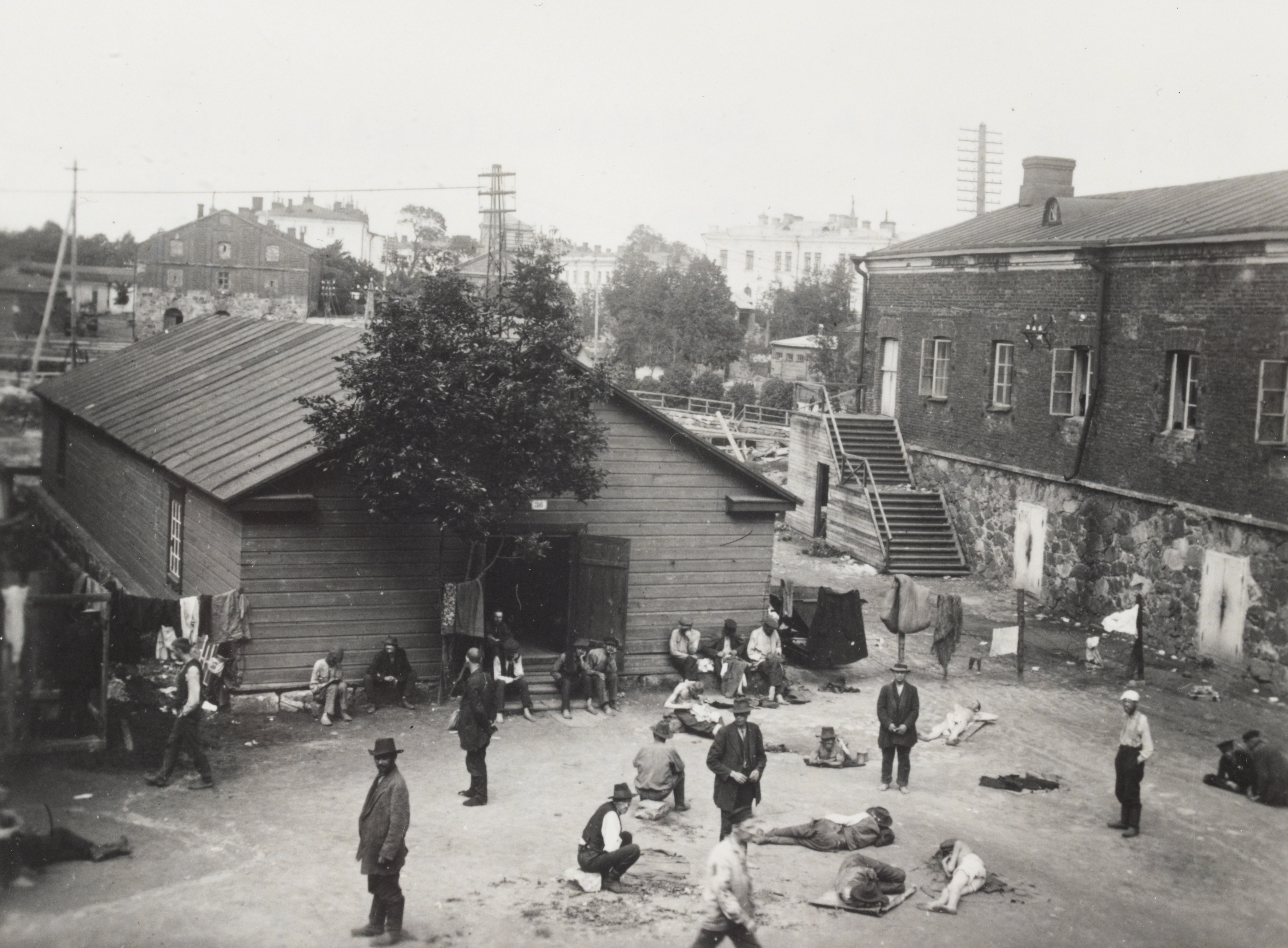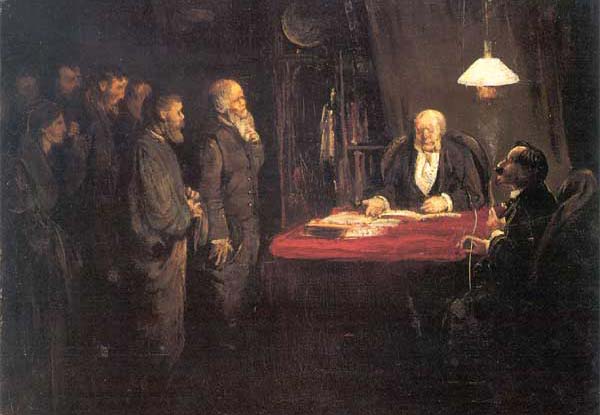|
Tuomas Bryggari
Tuomas Bryggari (8 December 188131 October 1964) was a Finnish trade unionist, politician and member of the Parliament of Finland, the national legislature of Finland. A member of the Social Democratic Party, he represented Vaasa Province East between September 1922 and July 1948. Prior to being elected, he was imprisoned for political reasons following the Finnish Civil War. Early life Bryggari was born on 8 December 1881 in Jääski in the south-east of the Grand Duchy of Finland. He was the son of Paavo Bryggari and Maria Himmanen. He studied at public school for three grades. Bryggari started working as a child and had many jobs during his early life: farm worker/cattle herder, wheelwright, forestry worker, railway construction worker, dockworker and stonemason in Jääske and Helsinki. He was a construction worker on the Jyväskylä–Pieksämäki railway. Trade unionism Bryggari became involved in trade unionism in 1905 and was blacklisted by employers. He was a speak ... [...More Info...] [...Related Items...] OR: [Wikipedia] [Google] [Baidu] |
Parliament Of Finland
The Parliament of Finland ( ; ) is the Unicameralism, unicameral and Parliamentary sovereignty, supreme legislature of Finland, founded on 9 May 1906. In accordance with the Constitution of Finland, sovereignty belongs to the people, and that power is vested in the Parliament. The Parliament consists of 200 members, 199 of whom are elected every four years from 13 multi-member districts electing 6 to 37 members using the proportional D'Hondt method. In addition, there is one member from Åland. Legislation may be initiated by either the Finnish Government, Government or one of the members of Parliament. The Parliament passes legislation, decides on the state budget, approves international treaties, and supervises the activities of the government. It may bring about the resignation of the Finnish Government, override presidential vetoes, and alter the constitution. To make changes to the constitution, amendments must be approved by two successive parliaments, with an election c ... [...More Info...] [...Related Items...] OR: [Wikipedia] [Google] [Baidu] |
Jyväskylä–Pieksämäki Railway
The Jyväskylä–Pieksämäki railway (, ) is a 1,524 mm (5 ft) railway in Finland, running between the Jyväskylä and Pieksämäki stations. History The decision to build the line was made in 1912, and the most difficult and expensive of the route options was chosen. The decision was influenced by the experience gained from the construction of the curved and hilly Haapamäki–Jyväskylä railway, which proved inadequate for the growing train traffic. The line became straightforward - plans to bypass Leppälahti and Pönttövuori were abandoned. In turn, the population centers of Hankasalmi and Kankainen were bypassed, which eventually led to the creation of the station villages of Hankasalmi, Sauvamäki and Venetmäki. The main challenges of the construction process were at the western end of the line - namely, the cliffs between Vaajakoski and Leppälahti, the long lake embankments and the tunnel through the Pönttövuori. The Jyväskylä-Pieksämäki line was the l ... [...More Info...] [...Related Items...] OR: [Wikipedia] [Google] [Baidu] |
Finnish Civil War Prison Camps
Finnish Civil War prison camps were operated by the White Finns to hold prisoners of war during and after the Finnish Civil War in 1918. Around 80,000 captured Red Guards and their families, including 4,700 women and 1,500 children, were held in prisoner of war camps across Finland.Red Prisoners MANNERHEIM – War of Independence. Retrieved 9 February 2015. University of Tampere. Retrieved 9 February 2015. They were composed of 13 main camps and more than 60 smaller sub-camps operated by the White Army during the summer of 1918. Conditions were very poor and camps suffered from high |
Leftist
Left-wing politics describes the range of political ideologies that support and seek to achieve social equality and egalitarianism, often in opposition to social hierarchy either as a whole or of certain social hierarchies. Left-wing politics typically involve a concern for those in society whom its adherents perceive as disadvantaged relative to others as well as a belief that there are unjustified inequalities that need to be reduced or abolished, through radical means that change the nature of the society they are implemented in. According to emeritus professor of economics Barry Clark, supporters of left-wing politics "claim that human development flourishes when individuals engage in cooperative, mutually respectful relations that can thrive only when excessive differences in status, power, and wealth are eliminated." Within the left–right political spectrum, ''Left'' and ''Right'' were coined during the French Revolution, referring to the seating arrangement in the ... [...More Info...] [...Related Items...] OR: [Wikipedia] [Google] [Baidu] |
Uusimaa Province
The Province of Uusimaa (, , ) was a province of Finland from 1831 to 1997. It was established in 1831, when the County of Nyland and Tavastehus was divided into the Häme Province and Uusimaa Province. In 1997 it was merged with the Kymi Province and the southern parts of the Häme Province into the new Southern Finland Province. History The beginnings of the province of Uusimaa lie in the Swedish governance reforms of 1634. At that time, new counties were established also in the territories of Finland. The five counties established in Finland were the counties of Uusimaa and Häme, the counties of Turku and Pori, the counties of Viipuri and Savonlinna, the province of Ostrobothnia and the county of Käkisalmi. Maps , , , Municipalities in 1997 (cities in bold) * Artjärvi * Askola * Ekenäs * Espoo * Hanko * Helsinki * Hyvinkää * Ingå * Järvenpää * Karis * Karjalohja * Karkkila * Kauniainen * Kerava * Kirkkonummi * Lapinjärvi * Liljend ... [...More Info...] [...Related Items...] OR: [Wikipedia] [Google] [Baidu] |
Marxists Internet Archive
Marxists Internet Archive, also known as MIA or Marxists.org, is a non-profit online encyclopedia that hosts a multilingual library (created in 1990) of the works of communist, anarchist, and socialist writers, such as Karl Marx, Friedrich Engels, Vladimir Lenin, Leon Trotsky, Joseph Stalin, Mao Zedong, Rosa Luxemburg, Mikhail Bakunin, Peter Kropotkin, and Pierre-Joseph Proudhon, as well as that of writers of related ideologies, and even unrelated ones (for instance, Sun Tzu). The collection is maintained by volunteers and is based on a collection of documents that were distributed by email and newsgroups, later collected into a single gopher site in 1993. It contains over 180,000 documents from over 850 authors in 80 languages. All material in the archive is provided free of charge to users, although not necessarily free of copyright. History Origins The archive was created in 1990 by a person known only by their Internet tag, Zodiac, who started archiving Marxist texts by ... [...More Info...] [...Related Items...] OR: [Wikipedia] [Google] [Baidu] |
Kustannusosakeyhtiö Tammi
Tammi, also known as Kustannusyhtiö Tammi and Tammi Publishers, is a Finnish publishing company established in 1943 by an initiative of Väinö Tanner, leader of the Social Democratic Party of Finland. In 1996, the company was bought by the Bonnier Group, and, as of the early 2000s, it was the third largest book publisher in Finland. In 2018, the company was merged into the Finnish book publishing company Werner Söderström Osakeyhtiö (WSOY). Tammi was formerly known as Kustannusosakeyhtiö Tammi. Its series ''Keltainen kirjasto'' (Yellow library), published since 1954, specialises in "quality literature", including books by many recipients of the Nobel Prize in Literature. Controversy over Yrjö Leino memoirs Yrjö Leino, a Communist activist, was Finland's Minister of the Interior in the crucial 1945–48 period. In 1948 he suddenly resigned for reasons which remain unclear and went into retirement. Leino returned to the public eye in 1958 with his memoirs of his time as M ... [...More Info...] [...Related Items...] OR: [Wikipedia] [Google] [Baidu] |
Oskari Tokoi
Antti Oskari Tokoi (15 April 1873 – 4 April 1963) was a Finnish socialist politician who served as a leader of the Social Democratic Party of Finland. Tokoi became Chairman of the Senate of Finland in 1917, and thus, he was the world's first social democratic leader of the government. During the short-lived Revolution of 1918, Tokoi participated as a leading figure in the revolutionary government. Tokoi later emigrated to the United States, where he served as the long-time editor of '' Raivaaja'' (The Pioneer), the newspaper of the Finnish Socialist Federation. Life and Politics Early years Oskari Tokoi was born as Antti Oskari Hirvi in Yliviirre parish, Kannus in the Central Ostrobothnia region of Finland on May 15, 1873. The family adopted the surname "Tokoi," the name of a farm purchased by his paternal grandfather, in accordance with common local practice in this period. His father, Kalle, was a farmer and horse-trader. With the economic situation grim, Tokoi's uncle em ... [...More Info...] [...Related Items...] OR: [Wikipedia] [Google] [Baidu] |
Senate Of Finland
The Senate of Finland (; ) combined the functions of Cabinet (government), cabinet and supreme court in the Grand Duchy of Finland from 1816 to 1917 and in independent Finland from 1917 to 1918. The body that would become the Senate was established on August 18, 1809, when Tsar Alexander I of Russia summoned the Diet of Porvoo and directed the Diet_(assembly), Diet to draw up regulations for a Government Council.Jutikkala, Eino and Pirinen, Kauko. ''A History of Finland''. Dorset Press, 1988 p. 162. In 1816, Alexander renamed this body the ''Senate'' to demonstrate that it was equal to rather than inferior to Governing_Senate, its Russian equivalent.Jutikkala, Eino and Pirinen, Kauko. ''A History of Finland''. Dorset Press, 1988 p. 163. The Senate was headed by the Governor-General of Finland. The members of the Senate had to be Finnish citizens. The Senate was divided into the economic division and the judicial division. In 1822 both divisions were given a Finnish vice-chair ... [...More Info...] [...Related Items...] OR: [Wikipedia] [Google] [Baidu] |
Mikhail Aleksandrovich Stakhovich
Mikhail Aleksandrovich Stakhovich (; 20 January 1861, in Oryol Governorate – 23 September 1923, in Aix-en-Provence) was a Russian politician. Stakhovich was elected to the Duma in 1906 as an Octobrist and again to the second Duma in 1907, leading the Party of Peaceful Renovation. He was appointed Governor-General of Finland by the Russian Provisional Government on 20 March 1917 after the job was refused by Vladimir Dmitrievich Nabokov amongst others. He resigned on 17 September. After the Governor-General's post, Stakhovich was pointed as Ambassador to Madrid but before he could reach Madrid the October Revolution took place. Stakhovich died in exile in Aix-en-Provence, France in 1923. He was buried in Sainte-Geneviève-des-Bois Russian Cemetery, in the southern suburbs of Paris. Awards * Order of Saint Anna The Imperial Order of Saint Anna (; also "Order of Saint Anne" or "Order of Saint Ann") was a Holstein ducal and then Russian imperial order of chivalry. It w ... [...More Info...] [...Related Items...] OR: [Wikipedia] [Google] [Baidu] |
Governor-General Of Finland
The governor-general of Finland was the military commander and the highest administrator of Finland sporadically Finland under Swedish rule, under Swedish rule in the 17th and 18th centuries and continuously in the autonomous Grand Duchy of Finland between 1809 and 1917. Swedish realm After the final abolition of the Duchy of Finland and related feudal privileges in the late 16th century, the king of Sweden sporadically granted most or all of Finland under a specially appointed governor-general, who took care of the matters in the eastern part of the country more or less according to his own best judgement. The best-known of these officials is Count Per Brahe the Younger, who served as Governor-General of Finland in the 17th century. His tenure, remembered as a period of reforms and progress in both economy and education, is referred to in Finnish as "kreivin aika" ("the count's era"). Over the centuries, the phrase has taken on a new meaning and is now commonly used to describ ... [...More Info...] [...Related Items...] OR: [Wikipedia] [Google] [Baidu] |
Strike Action
Strike action, also called labor strike, labour strike in British English, or simply strike, is a work stoppage caused by the mass refusal of employees to Working class, work. A strike usually takes place in response to employee grievances. Strikes became common during the Industrial Revolution, when Labour economics, mass labor became important in factories and mines. As striking became a more common practice, governments were often pushed to act (either by private business or by union workers). When government intervention occurred, it was rarely neutral or amicable. Early strikes were often deemed unlawful conspiracies or anti-competitive cartel action and many were subject to massive legal repression by state police, federal military power, and federal courts. Many Western nations legalized striking under certain conditions in the late 19th and early 20th centuries. Strikes are sometimes used to pressure governments to change policies. Occasionally, strikes destabilize the r ... [...More Info...] [...Related Items...] OR: [Wikipedia] [Google] [Baidu] |





